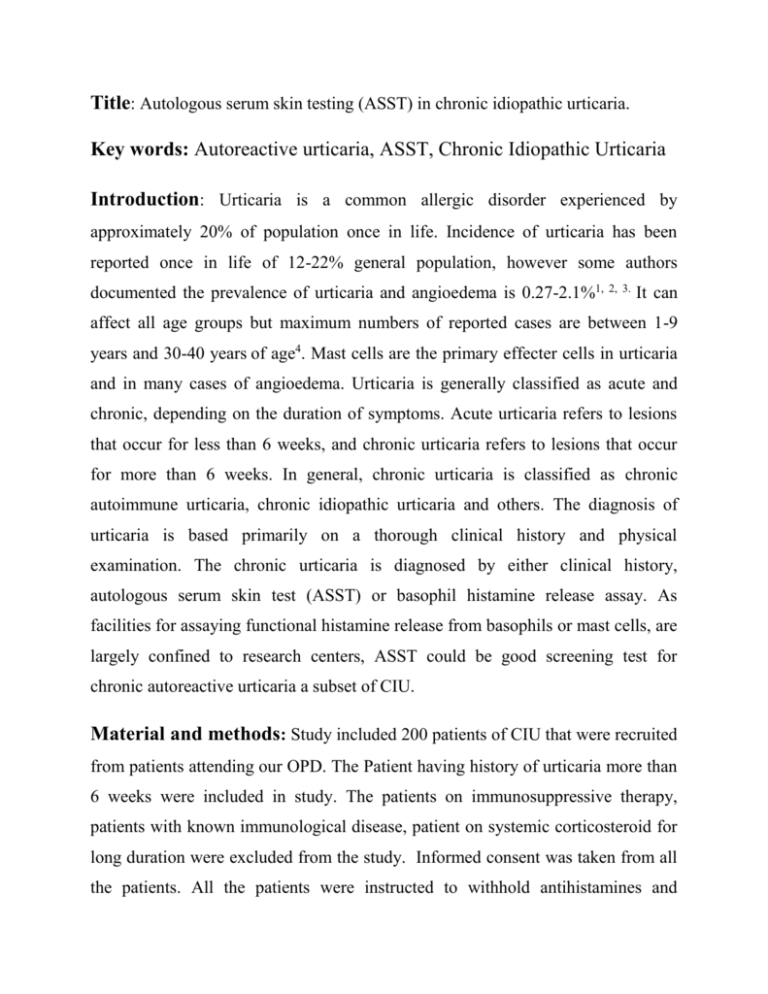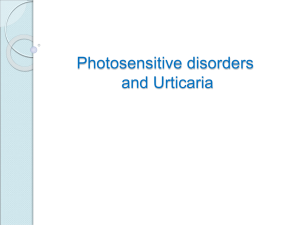et al - jemds
advertisement

Title: Autologous serum skin testing (ASST) in chronic idiopathic urticaria. Key words: Autoreactive urticaria, ASST, Chronic Idiopathic Urticaria Introduction: Urticaria is a common allergic disorder experienced by approximately 20% of population once in life. Incidence of urticaria has been reported once in life of 12-22% general population, however some authors documented the prevalence of urticaria and angioedema is 0.27-2.1%1, 2, 3. It can affect all age groups but maximum numbers of reported cases are between 1-9 years and 30-40 years of age4. Mast cells are the primary effecter cells in urticaria and in many cases of angioedema. Urticaria is generally classified as acute and chronic, depending on the duration of symptoms. Acute urticaria refers to lesions that occur for less than 6 weeks, and chronic urticaria refers to lesions that occur for more than 6 weeks. In general, chronic urticaria is classified as chronic autoimmune urticaria, chronic idiopathic urticaria and others. The diagnosis of urticaria is based primarily on a thorough clinical history and physical examination. The chronic urticaria is diagnosed by either clinical history, autologous serum skin test (ASST) or basophil histamine release assay. As facilities for assaying functional histamine release from basophils or mast cells, are largely confined to research centers, ASST could be good screening test for chronic autoreactive urticaria a subset of CIU. Material and methods: Study included 200 patients of CIU that were recruited from patients attending our OPD. The Patient having history of urticaria more than 6 weeks were included in study. The patients on immunosuppressive therapy, patients with known immunological disease, patient on systemic corticosteroid for long duration were excluded from the study. Informed consent was taken from all the patients. All the patients were instructed to withhold antihistamines and corticosteroids at least for 3 days prior to ASST. Autologous serum skin testing (ASST) was done after fulfilling criteria for inclusion in study. Preparation of serum: Five ml venous blood was withdrawn by sterile disposable syringe and collected into sterile glass tubes without accelerator or anticoagulant. Red-topped 7 ml BD Vacutainer® blood collection tubes (no additive) (Becton, Dickinson and Company, Franklin Lakes, New Jersey, USA) are used for blood collection. Blood allowed to clot at room temperature for 30 min before separation. Serum was separated with the help of centrifuge at 3000 rotation/minute for 5 min with the help of REMI R8C Centrifuge machine. Always fresh serum was used for skin testing to minimize any risk of sample contamination. Serum skin testing technique: The ASST was performed with a 1 ml sterile insulin syringe and needle 27G × 12.7 mm without dead space .Two units insulin syringe of fresh undiluted serum injected on volar aspect of left forearm 5cm below the elbow crease after cleansing with antiseptic (spirit) solution. A superficial intradermal injection was made by introducing the bevel of the needle uppermost and aiming to raise a palpable ‘bleb’ of fluid within the papillary dermis and forming a typical papule measure 6–7 mm. Same amount of normal saline was injected in volar aspect of right forearm as a control We avoid injecting serum near wrist and at skin known to have had spontaneous wheals in the previous 48 h. Skin test reading: The result was noted after 30 minutes. We did cross-lighting the skin tests and marking the oedema edge with a ballpoint pen before measuring between the points with a ruler marker. The size of the red wheal response was documented with any atypical or late onset reactions. We took the mean of the two longest perpendicular red wheal diameters if wheal was not round. Result was categorized as positive and negative according to size of wheal. ASST was interpreted as positive if firstly, a red serum-induced wheal response is present at 30 min (usually surrounded by flare) in the absence of a reaction to the saline i.e. negative control skin test. Secondly, if a minimum difference of 1.5 mm in mean perpendicular wheal diameter between the autologous serum-induced response and saline-induced response. The ASST was considered un-interpretable if a red wheal reaction develops at the saline skin test site. Statistical analysis : The statistical analysis was done using Chi-square test for non parametrical data and if p< 0.05, then the test was considered statistically significant and a Student T- test while comparing two groups of unequal variance. Descriptive statistics were used to summarize the clinical characteristics and risk factors of the subjects Results: Out of 200 patients 100 were male and 100 were female. Mean age of patients was 31.9 yrs. Most common age group was 25-34yrs. ASST was found positive in 36(18%) of patients. In most of the patients duration of disease was less than 11months (42%) with the mean duration of disease 21.74months.Mean duration of wheal was 64.7 minutes, in which most of the patients (112) having duration of wheal less than 59 min (Table 1) . History of angioedema was positive in total 109 patients (54.5%). The history of excessive wheals at night positive in 99 patients and in day time in 14 patients and 87 patients do not specify any diurnal variation .History of Aggravating factors was positive in 50 patients (25%) in which drugs and cold were the most common aggravating factors. Family history of urticaria and angioedema was positive in 35 patients. In routine investigation Erythrocyte Sedimentation rate (ESR) was raised in 37 patients, Total Eosinophil count (TEC) was raised in 24 patients and abnormal renal function test was found in one patient (Table 2). Clinical profile of ASST positive patients was as follow: Most common age group was 25-34yrs.There was no statistically significant difference in sex distribution in ASST positive and ASST negative patients. Mean age of ASST positive patients were 35.05years as compare to ASST negative patents 31.12years, that is statistically not significant. Mean duration of disease in ASST positive patients was 20.69 months as compared to 21.97 months of ASST negative patients. The difference was statistically not significant. Mean duration of wheals was 97.3 minutes in ASST positive patients as compare to 57.5 minutes in ASST negative which was statistically significant (Table 3). Out of 36 ASST positive patients, 23(63.39%) having history of Angioedema and out of 164 ASST negative patients, 86 (52.44%) having history of Angioedema. It was noted that there is no significant association between history of Angioedema & ASST positivity (P > .05)[Table 4].Out of 36 ASST positive patients, 17(47.22%) and out of 164 ASST negative patients, 57 (34.76%) having associated systemic Symptoms. It was noted that there is no significant association between associated systemic symptoms and ASST (P > .05). Family history of urticaria and angioedema was present in only 6 out of 36 ASST positive patients, and out of 164 ASST negative patients, 29 (17.68%) having family history of urticaria and angioedema. It was noted that there is no significant association between family history & ASST positivity (P >0 .05). None of patient in our study complained any adverse effect due to ASST testing either during testing or thereafter. Discussion: In various studies the frequency of ASST positive response in adult patients of chronic idiopathic urticaria (CIU) range from 4.1% to 76.5% using different criteria for positivity.5,6,7 The frequency of ASST positivity in chronic urticaria patients in our study (18%) is comparable with earlier studies. 6, 7 Variance in ASST positivity in different studies could be attributable to the patient selection, disease severity, methodology, duration of avoidance of drugs, interpretation or even to the true prevalence of auto reactive urticaria in the population tested. Among the methodology, important factors are amount of the serum to be injected, duration of test reading and criteria for positivity in which most important one is diameter of wheal. There is controversy about the duration of avoidance of drugs that the patient was taking before the test. However the antihistaminic should be withhold to maximum of 72 hour but longer periods of time have been advocated as the pharmacodynamic effects of antihistamines in skin may last longer than that indicated by their plasma half-lives (e.g. loratadine). No published information exists on the potential inhibitory effects of leukotriene receptor antagonists on ASST. Studies regarding effect of systemic corticosteroids on the ASST response were lacking in literature .So all the above factors and variations with ASST need to be standardized and a uniform ASST technique could be developed so we could get standardised and meaningful results. Overall age and sex profile of our patients in both the groups was statistically similar and comparable to previous studies. Ferre et al8 studied 539 patients with urticaria with or without history of angioedema and concluded that the mean age of urticaria/angioedema patients was 35.75 ± 18.9 years. Our study shows the most common age group 25-34yrs with mean age 31.9 years. There was no statistically significant difference between age and sex distribution among ASST positive and ASST negative patients. Mohan Singh et al 9 found the sex distribution was nearly equal and the patients age ranged from 1 to 69 years (mean age of onset of urticaria was 31.2 + 13.5 years). Martina et al studied 238 patients with urticaria and found that median duration of their urticaria and/or angioedema 15 months (most common group was disease with 3-5 months)11. Zülal Erbagci et al studied 30 adult patients and found mean duration of disease in this group was 11.56 months12. Mamatha et al.13 also reported a median duration of 12 months in the ASST-positive patients as compared with 15 months in the ASST-negative patients and there was no significant difference in these two groups. In our study mean duration of urticaria was 21.74months with most of the patients (41%) having less than 11 month duration which is consistent with earlier studies. We did not find any significant difference in the duration of disease among ASST positive and ASST negative patients. Sabroe et al reported the median duration of disease was 12 and 15 months for ASST-positive and -negative patients respectively, which was not statistically significant. Lesions lasted for significantly longer durations in patients with a positive ASST, median duration being four hours when compared to two hours in ASST negative individuals ( P = 0.001)14. Similarly in our study there was no statistically significant difference in duration of disease between these two (ASST+ & ASST-) groups, whereas there was significantly higher duration of wheal found among ASST positive patients. In our study history of angioedema was present in 54.5 % (109/200) patients and there was no statistically significant difference between ASST positive or negative patients. Similarly Swerdt et al. observed angioedema in 86% of the ASST-positive and 67% of the ASST-negative patients, respectively, they found no statistical significance15. Surbhi Vohra et al concluded that both the ASSTpositive and the ASST-negative groups had associated angioedema and were comparable statistically for the number of episodes and sites involved10. Martina M et al found that associated systemic symptoms during attacks of urticaria or angioedema were dyspnoea (13%), hoarseness (9%), and a swollen tongue or throat (7%) 11 . Whereas Mamatha G et al failed to reveal such associations13. In our study associated Systemic Symptoms was present in 74 (37%) patients and it was noted that there is no significant association between associated Systemic Symptoms & ASST positivity. Maj Kraig W et al studied 125 patients with chronic urticaria and evaluated them with 11 commonly recommended laboratory and radiologic procedures. Abnormal studies were obtained in 26 (20.8%) of these patients in which ESR was raised in 6 out of 74 patients, ANA was positive in 1 out of 99 patients and total eosinophil count raised in 2 out of 99 patients found. They found that the majority of these abnormalities were evident from the initial history and physical examination. They concluded that, these laboratory studies are not likely to be helpful in the evaluation of chronic idiopathic urticaria unless there are suggestive findings in the history and physical examination 16. In our study raised ESR was found in 37 patients (18.5%), increased TEC was present in 24 patients and abnormal renal function test was present in only 1 patient. Similarly differential cell count was raised in 16 patients. Like other studies all the laboratory parameters do not specify any significant association neither with urticaria itself nor with ASST positivity. O' Donnel et al noted higher frequency of autoimmune disease in patients with autoimmune urticaria17. But our study failed to demonstrate any significant association with autoimmune disease and chronic urticaria in which no patient was found ANA positive. There is controversy about the relationship between ASST positivity and disease severity. Sabroe et al18 showed that patients with positive serum tests had more wheals, in a wider distribution, higher itch scores and more systemic symptoms, than those with negative tests. Similarly, Caproni et al.19 showed that the overall frequency of urticarial episodes during the week before skin testing and number of spontaneous wheals was greater in the ASST positive group. Staubach et al.20 demonstrated that ASST positive patients required significantly more antihistamines than ASST negative patients and experienced a marginally (but not significantly) longer duration of CIU. Patients with autoreactive urticaria have no distinctive diagnostic clinical features. Autoreactive and non-autoreactive cases are indistinguishable clinically and histologically. However, they do tend to have more severe urticaria21. Conclusion: ASST is easily practicable test available to clinicians to detect autoimmune urticaria. It is a simple, inexpensive, semi invasive and easy-toperform test which can be done and recorded by the dermatologist himself to determine whether the patient's CIU is autoimmune in origin. When conventional approaches in management of CIU unsuccessful, ASST is especially important from the therapeutic point of view as it can help the dermatologist to initiate immunosuppressive therapy in such patients. ASST would be good test to exclude autoreactive urticaria a subset CIU among the patients whose wheals were persisting longer. References: 1. Swinny B. The atopic factors in urticaria. South med J 1941; 34: 855-87. 2. Mchee WD. The incidence of familial occurrence of allergy. J Allergy 1966; 38: 226-3. 3. Schafer T, Ring J. Epidemiology of urticaria. Monogr Allergy. 1993; 31:4960. 4. Handerson RL, Fleischer AB and Feldman SR. Allergist and dermatologist have far more expertise in carring for patients with urticaria than other specialists. J Amc Acd Dermatol 2000; 43:1084 5. Niimi N, Francis DM, et al. Dermal mast cell activation by autoantibodies against the high affinity IgE receptor in chronic urticaria. J Invest Dermatol. 1996; 106: 1001-6. 6. Godse KV. Autologous serum skin test in chronic idiopathic urticaria. Indian J Dermatol Venereol Leprol. 2004 ;70:283-4 7. Staubach P, Eckhardt-Henn A, Magerl M et al. Quality of life in patients with chronic urticaria is differentially impaired and determined by psychiatric comorbidity. Br J Dermatol 2006; 154:294–8 8. M Ferre. Epidemiology, healthcare, resources, use and clinical features of different types of urticaria. J Investig Allergol Clin Immunol 2009; 19: 21-6. 9. Mohan Singh, Surrinder Kaur, AJ Kanwar. Evaluation of the causes of physical urticarias. IJDVL 1990; 56: 109-11 10. Surbhi Vohra, Nand Lal Sharma, et al. Clinicoepidemiologic features of chronic urticaria in patients having positive versus negative autologous serum skin test: A study of 100 Indian patients. 2011; 77: 156-9. 11. Martina M. A. Kozel, et al. The Effectiveness of a History-Based Diagnostic Approach in Chronic Urticaria and Angioedema. Arch Dermatol. 1998; 134:1575-80. 12. Zülal Erbagci, MD. The leukotriene receptor antagonist montelukast in the treatment of chronic idiopathic urticaria: A single-blind, placebo-controlled, crossover clinical study. The journal of allergy and clinical immunology. 2002; 110: 484-8. 13. Mamatha G, Balachandran C, Smitha P. Chronic idiopathic urticaria: comparison of clinical features with positive autologous serum skin test. Indian J Dermatol Venereol Leprol 2008; 74:105–8 14. Sabroe RA, Grattan CE, et al. The autologous serum skin test: a screening test for autoantibodies in chronic idiopathic urticaria. Br J Dermatol 1999; 140: 446–52. 15. Swerdt AD, Keybus CV et al. Detection of basophil-activating IgG autoantibodies in chronic idiopathic urticaria by induction of CD63. J Allergy Clin Immunol 2005; 116:662-7 16. Maj Kraig W Maj Kraig W. Jacobson, et al MC Laboratory Tests in Chronic Urticaria. JAMA 1980; 243:1644-6 17. O'Donnell BF, O'Neill CM et al. Human leucocyte antigen class II associations in chronic idiopathic urticariaBr J Dermatoj. 1999 ; 140:853-8 18. Sabroe RA, Seed PT et al. Chronic idiopathic urticaria: comparison of the clinical features of patients with and without anti-FcepsilonRI or anti-IgE autoantibodies. J Am Acad Dermatol 1999; 40:443–50. 19. Caproni M, Volpi W, Melani L et al. Chronic idiopathic and chronic autoimmune urticaria: clinical and immunopathological features of 68 subjects. Acta Derm Venereol 2004; 84:288–90 20. Sabroe RA, Seed PT et al. Chronic idiopathic urticaria: comparison of the clinical features of patients with and without anti-Fc epsilon RI or anti-IgE autoantibodies. J Am Acad Dermatol 1999; 40:443–50. 21. Greaves MW. Chronic urticaria. N Engl J Med. 1995; 332: 1762–72. Table No.-1 Distribution according to Duration of disease Duration of disease No. % (In month) < 11 84 42.00 12-23 48 24.00 24-35 17 8.50 36-47 15 7.50 48-59 13 6.50 60+ 23 11.50 Total 200 100.00 Table No.-2 Laboratory Parameters & ASST Laboratory Parameters Raised ESR Raised TEC Raised RFT ASST Total (n=200) + ve (n=36) - ve (n=164) 5 (13.89) 6 (16.67) 0 (0.00) 32 (19.51) 18 (10.97) 1 (0.61) 37 (18.50) 24 (12.00) 1 (0.50) Table No.-3 Mean + Sd of duration of wheal (in min) according to ASST ASST Duration of Wheal + ve (n=36) 97.36 + 104.70 - ve ( n=164) 57.56 + 59.29 P-value Significance < .05 Sig Table No.-4 History of Angioedema & ASST Angioedema Present Absent Total ASST Total + ve - ve 23 (11.50) 13 (6.50) 36 86 (43.00) 78 (39.00) 164 109 (54.50) 91 (45.50) 200 (18.00) χ = 1.560 Odd ratio = 0.623 2 d.f.=1 (82.00) P > .05 (100.00) NS






